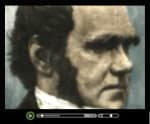Charles Darwin
Charles Darwin and the Origin of Species
In 1831, "Charles Darwin" sailed as a passenger on the HMS Beagle. His five-year voyage took him to the coasts of South America, where he observed various kinds of animals. One set of creatures in particular, the Galapagos finches, caught Darwin's attention. He studied the birds, collected samples, and observed that they had various beak sizes and shapes. These observed variations inspired the initial development of Darwin's "Theory of Origins." He returned to England in 1836.
In 1842, Darwin began drafting On the Origin of Species by Means of Natural Selection, or the Preservation of Favoured Races in the Struggle for Life (often referred to simply as Origin of Species). His work was heavily influenced by Sir Charles Lyell's Principles of Geology (1830) and Thomas Malthus' An Essay on the Principle of Population (1798). Origin of Species was ultimately published in 1859.
Guess what? I liked Darwin's book. In a nutshell, Origin of Species proposes "Natural Selection" as the mechanism by which an original simple-celled organism could have evolved gradually into all species observed today -- both plant and animal. Generally, Darwin presents a theory of evolution, which he defines as "descent with modification." It's a fun read, and a compelling hypothesis for the time.
However, 100 years later, scientists realized that Darwin's basic theory needed work -- "Natural Selection" is a conservative process, not a means of developing complexity from simplicity. As scientists started understanding the nature of genetics, they were forced to update Darwin's original theory. They proposed that Natural Selection, in conjunction with genetic mutation, allowed for the development of all species from a common ancestor. Although true beneficial mutations have never been observed (scientists only observe harmful, "downward" mutations), this is today's general conjecture regarding evolutionary change.
But what about the "common ancestor" at the bottom of the evolutionary tree?...
Next Page!

